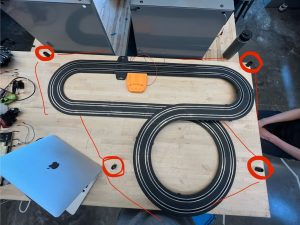This week on the project, I started developing a new filtering strategy for the bounding box sizes which used a double exponential smoothing algorithm I found outlined online. Initially the performance wasn’t as good as the simple moving average algorithm I was initially using, but with some tuning of the value and trend parameters I ended up getting it to perform about as well during testing as the SMA. Next, I’d like to informally compare the two filtering algorithms to determine which one performs better on our decided track for demo day. I’ll use the eye test to determine which one is more accurate in switching to the desired camera, and which one is more desirable with respect to the timing of switching, since currently one of our goals for improvement of the feed selection algorithm is for it to switch earlier so that people can see the car coming into the camera’s field of vision instead of switching late. I updated our main branch to support 3 cameras, up from 2, for a demo during our meeting with Prof. Kim on Wednesday, and following that updated it to support 4 cameras, which is the number of cameras we will be using on demo day. I also started developing a subsystem that tracks the order that the camera feeds were displayed in in the previous laps, with the goal of using the historical information to predict the next camera to switch to, since the switch will need to occur even before the camera sees the car in order for people to be able to see the car coming into the camera’s field of vision. I haven’t been able to finish the initial implementation of this new subsystem yet, but so far I have a partially completed version of it which I am debugging. Towards this end I have made some changes to the system to make testing more efficient, by adding a feature that allows the camera feeds to switch while the livestream is paused to check what each camera was seeing when it was paused, and by adding a feature which allows each camera to capture and use its own color profile instead of one camera capturing the color profile for all the other cameras. I made it so that if the color profile captured for one of the cameras isn’t detecting the car very well, it can be easily redone without having to restart the system.
Since we are now in the last two weeks of the project, I would like to be able to complete the new subsystem I am working on by next week in order to give some slack time before our demo on Friday. Towards that end, I plan on finishing debugging my partial version by Tuesday and then ideally finishing the initial implementation by Wednesday night, leaving myself Thursday through Saturday for debugging and any additional work that might come up.
In order to accomplish my tasks during the course of this project, I have needed to learn how to write code using the OpenCV library. The learning strategy I used for this was primarily reading through the OpenCV documentation online, and following some additional 3rd party tutorial sources online when it seemed like the documentation was outdated or not as good as I would like it to be. I also needed to learn how to configure Git source control for files larger than 250 MB, because we were having trouble setting up our source control repository for our code which included a very large machine learning model in the initial stages of our project. The learning strategy I used for this was following the recommendation of the Git output when the push failed and reading through the documentation for Git LFS, which allowed us to set up source control that worked. Finally, I needed to learn how to filter noisy data in order to get a usable bounding box size time series data for the feed selection algorithm. The learning strategy I used for this was looking at online explanations of various filtering strategies starting from SMA on Wikipedia. Potentially I could have reviewed the material I learned in 18290, but unfortunately I wasn’t able to figure out which parts of the material could be helpful for me since it seems mostly mathematical and not applicable to my situation.

